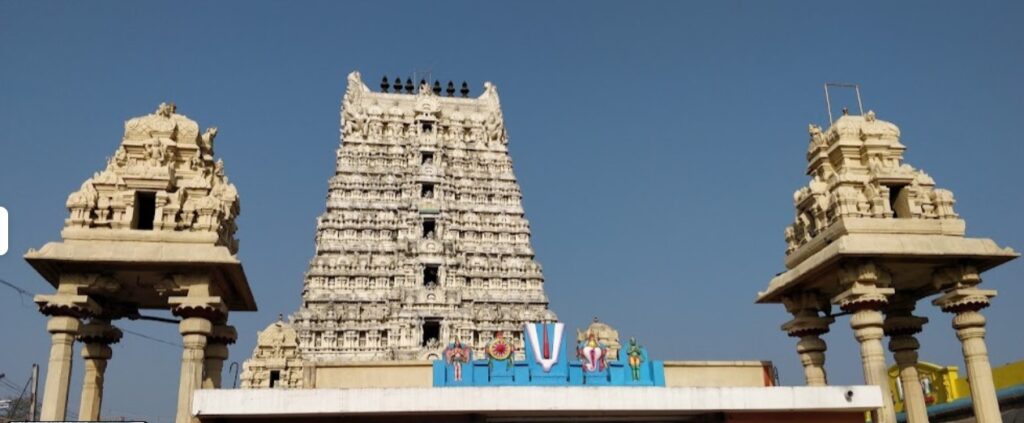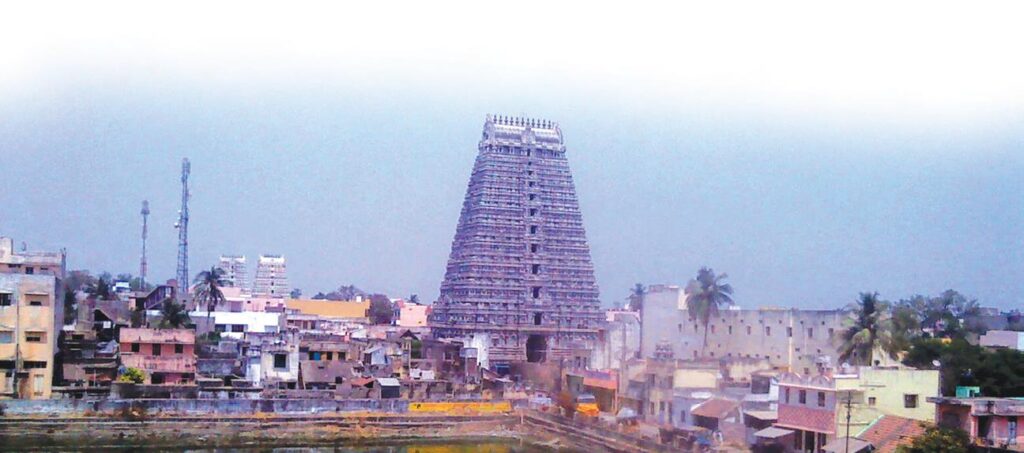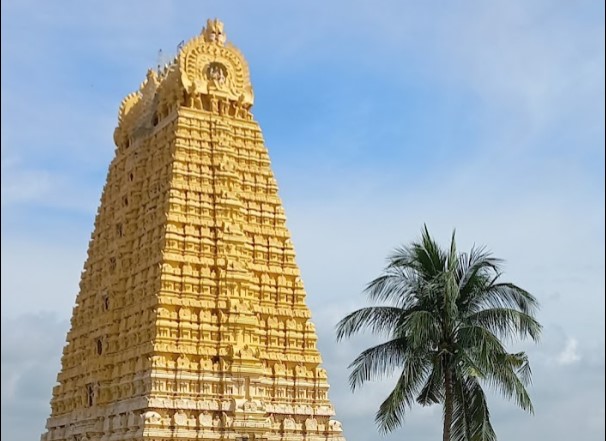Sri Ulagalantha Perumal Temple
Thirukoilure Location
Tirukoilur also spelt as Tirukkoyilur or Tirukovilur is a city and the headquarters of Tirukoilur taluk in Kallakurichi District, Tamil Nadu, India. Thirukovilur is located 34km towards the west of the district headquarters Villupuram in Tamilnadu. It is on the Panruti-Vellore route. It is a small town with a very ancient temple.
Click here for Google Maps Location
Sri Ulagalantha Perumal Temple – Sthala Puranam
King Mahabali was the grandson of Prahlada. The king was known for his prowess and had brought all the worlds under his control. Lord Indra, fearful of losing control over his domain appealed to Lord Narayana for relief. The Lord descended as Vamana, the dwarf bachelor.
He went to Mahabali’s ‘yajna’ and requested for a donation. The King asked what he wanted. Lord Vamana replied to three steps of land as measured by His foot. Mahabali thought this bachelor did not know what he needed to survive and offered a lot of wealth.
Lord Vamana responded that if he can offer all this, surely, three steps of land should be possible. Shukracharya, the preceptor of the ‘asuras’ realised who Vamana is and cautioned Mahabali to withdraw from the gifting ritual.
Mahabali, renowned as the man of his word, declined to do so and went ahead. As soon as the ritualistic exchange of water from Mahabali’s hand to Lord Vamana’s hand took place completing the process of donation, the Lord started growing to His Trivikrama form.
With one foot, He measured all of this world. With another step, He measured all of the heavens. It is in this form, with one leg raised, the Lord gives ‘darshan’ in Thirukovilur to Prahalada, Shukracharya and the first three Alwars in addition to Lord Brahma, Lord Indra and the sage Mrikandu.
This temple finds mention in old Tamil literature which dates to the period 3rd century BCE to 3rd century CE. This makes the original temple over two thousand years old. Initially built of bricks, it was later converted to a stone structure by medieval Cholas.
It spans 5 acres of land near the South Pennar River.

Sri Ulagalantha Perumal Temple – Special Features
Nalayira Divya Prabhandham was born in this place. The very first ‘pasuram’ was uttered by the three first Alwars here. The three Alwars met on a rainy day in this small village and the Lord joined them.
Poigai Alwar while travelling landed up in Thirukovilur during heavy rains. He sought shelter in a small passage in front of an ashram. Then Bhoothath Alwar also arrived there asking for shelter. The two sat together in the available space. Then Pei Azhwar also arrived. The three stood in the passage.
Suddenly they felt the presence of an unseen fourth person crowding the small space. Realising that the Lord was with them, they composed poetry in the ‘Andhadhi’ style (the last word of the pasuram is the first word of the next pasuram) – each 100 stanzas.
- One took the path of Bhakti.
- The other took the Jnana route and
- the third took the Parabhakti route to visualize the Lord using the light of the lamps of ‘bhakti’ and ‘jnana’ lit by the other two.
All three having seen the Lord, Pei Alwar outlines the vision of the Lord and His Divine Consort opening the stanza by saying Thiru-kandaen – ‘I saw the divine lady. Pon meni kandaen – I saw the golden form.’ Since they are the first three Alwars in the Srivaishnavaite canon, their works appropriately are called Mudhal, Irandam and Mundram (First, Second and Third) Thiruandhadhi.
The temple is regarded as the ‘avatar sthalam’ of Nalayira Divya Prabhandham as the first three pieces of poetry were sung here.
Many say that the original deity of this temple is Lord Krishna. It is part of the five Krishna ‘sthalams’ of Tamil Nadu. The temple, known as Sri Ulagalantha Perumal temple finds mention in the Sangam literature around the 3rd century of the current era. The true age of the temple is unknown.
There are contributions from various Chola kings during many years ending with the Vijayanagar dynasty.
Cheng-Kamala Natchiyar / Poong-Kothai
The legend of Trivikrama is also connected to Thrikkakara temple of Kerala and Ulagalanda Perumal Koil of Kanchipuram. The main idol is more than 20 feet tall. Since the Lord holds the Panchajanya in His right hand and Sudarshana in His left, He is deemed to be giving knowledge to all those who approach Him.
The Lord is in standing posture facing east with one leg raised. The Universal Mother is ‘Cheng-Kamala Natchiyar’ or ‘Poong-Kothai’. The temple tank is ‘Chakra Theertham’. The Lord is also called ‘Idai-Kazhi Nathan’ (in Tamil) or ‘Dehali-Eswaran’ (in Sanskrit).
There is a shrine of Vishnu Durga in one of the ‘prakaras.’ There is also a 40 ft tall pillar on top of which, it is said, that Garuda prays to the Lord of this temple. Vaanavan Devi, the mother of King Rajaraja Chola and King Rajaraja himself were both born here as the mother hailed from this town.

Mangalasasanam
Poigai Alwar refers to the Bhakthi ‘marga’ to realize the Lord. He says with the earth as the vessel, the ocean surrounding as the ghee, he is using the sun with its rays as the light in the lamp to write these ‘pasurams’ in Tamil as garlands at the divine feet of the Lord.
He is requesting the Lord to remove all obstacles of ‘samsaara’ from his path so he can realize the Lord because of his bhakthi. In Mudhal Thiruandhadhi (2167), Poigai Alwar considers his meeting with the Lord.
Peria Vachan Pillai comments that if the Lord had gone inside the house, He would have met the ‘rishi’ staying there. If He had stayed outside, He would have met the people who live there. Instead, He chose to stay in the passage to be with His devotees who sang about him.
Bhoothath Alwar says that with his love for the Lord as the vessel, with his desire to realize the Lord as the ghee, he is using his melting thoughts as the wick to light the lamp of knowledge (Jnana) to realise Srimannarayana. In Irandaam Thiruandhadhi (2252), Bhoothath Alwar visualizes the consequences of Trivikrama ‘avatar’.
When the Lord (who rests on Adisesh emitting poison and fire), raised and grew His foot to measure the worlds–the left curved conch (Panchajanya) in his left hand made sound and the golden fire emitting discus (Sudarshana) started emitting fire to reduce the enemies to inaction.
The Alwar describes Trivikrama in all His stunning glory spanning all directions. The implication is that all the ‘nityasuris’ were alerted and alarmed to their intended state (conch blowing, discus emitting fire and Adisesha emitting poison and fire) hearing the Lord grow big as Trivikrama wondering who was attacking the Lord and if they should perform their duty of protecting Him.
In Mundram Thiruandhadhi, Pei Alwar completes the exercise. Poigai utilized that path of devotion to achieve Para-bhakthi. Bhootha utilized the path of ‘jnana’ to achieve ‘Para-jnana.’ Pei Alwar utilized what the other two have realized and sings of how the Lord is realized. ‘Thiru- Kandaen–I saw Her (Mahalakshmi).
I saw His golden form shining like the sun. I saw the Sudarshana that puts fear in the hearts of enemies in battle. I saw the left whorled conch in his hand also. I saw all this in the form of my dark-complexioned, sea-hued Lord.’
Between the three of them, they set the tone for the evolution of Nalayira Divya Prabhandham –a combined and consummate effort by twelve Alwars of whom these three were the first. The routes to achieve the Lord are dealt with by the Lord Himself in the Varaha Purana (His discourse to Sri Bhumi Devi) and the Bhagavad Gita. But here in three pasurams, four lines each, with the blinding brilliance of simple Tamil, the three Alwars give it to us.
Thirumangai Alwar in Thirunedunthandagam (2052-2081), refers to the Lord at Thirukovilur and encourages everyone to worship Him there. The Alwar speaks of Trivikrama ‘avatar’ in this and refers to Him as Ulagalandaan.
The Alwar says: ‘You are in a place filled with lotus-filled ponds, wide streets, parks and lush green vegetation and guarded by deities such as Kali.’ Let us all concentrate on worshipping the Lord of Thirukovilur. In his Parakala Nayaki state, Thirumangai Alwar refers to Thirukovilur in more than one place in Sirya Thirumadal and Periya Thirumadal as the residence of the Lord who measured the world.
Let us all concentrate on worshipping the Lord of Thirukovilur.
Click here and EXPLORE all 108 Divya Desams

